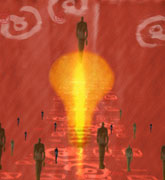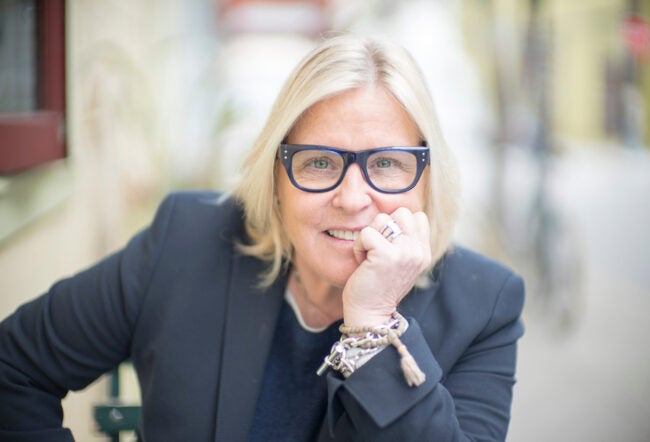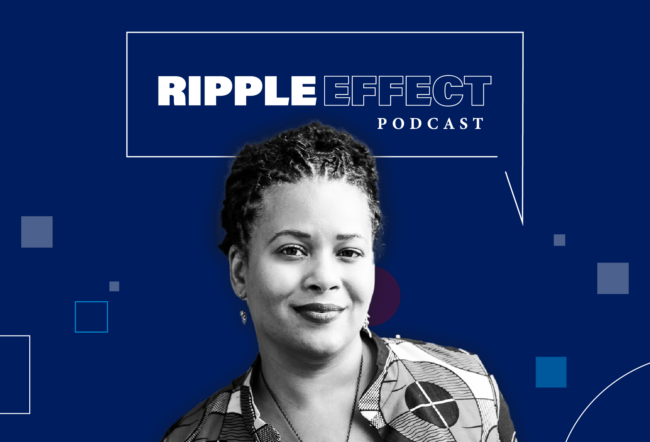In a perfect world, there would be faster computers, less lower back pain, more accurate ways to detect the warning signs of a heart attack and even better-fitting business attire for female executives. And that would mean more comfort and more time for enjoying the sweet things in life, like a gourmet chocolate bar.
If the finalists in the 2006-2007 Wharton Business Plan Competition — the “Eight Great,” as they are collectively known — are able to achieve their entrepreneurial schemes, the world would indeed become such a place. The finalists, who recently competed for more than $70,000 in prize money as well as the prestige of a competition gaining national attention, offered an array of proposed business ventures.
The diversity of the business plans at this year’s Venture Finals solidified the trend away from the Internet-oriented ventures that dominated the first two years of the competition, founded in 1998, when the word “entrepreneurial” seemed synonymous with “dot-com.” This year, only two of the eight finalists were involved in any type of computer technology — a high-speed semiconductor maker and an engineering software start-up.
But even if the dot-com bubble is beginning to seem like ancient history, interest in entrepreneurship and in the Wharton Business Plan Competition, sponsored by Wharton Entrepreneurial Programs, seems higher than ever. (This year’s winners, for example, were highlighted on CNN.com.) Indeed, the competitors represented the best of some 356 students and partners who entered the annual event earlier in the academic year. The eight finalists were chosen from a field of 151 teams; any team that included a Penn/Wharton student could participate.
At the April 24 finals, the teams were given 20 minutes to present the highlights of their plan and to answer questions from the panel of judges. This year’s judges included representatives of Johnson & Johnson, Adify, Schering-Plough, Norwest Venture Partners and Magic Sliders. The event brought together more than 200 entrepreneurs, venture capitalists, investment bankers, alumni, faculty and students.
Finalists received a total of $70,000 in combined prizes, including $20,000 in cash for the grand prize winner — who is also eligible for $10,000 in combined legal services. In addition, for the first time, the winner automatically gets to compete in the Draper Fisher Jurvetson Venture Challenge in New York City, with a shot at more than $250,000 in start-up money. This year, one entrant also made it to the semi-final round at MIT’s business plan competition, while another was named an inaugural winner of the Wharton Venture Award (WVA), receiving $10,000 to encourage the venture’s development over the summer.
So who are the 2007 winners? In keeping with custom, we will first list the entrants in alphabetical order — giving readers an opportunity to guess the outcome — before we announce the results.
Angiologix: This medical diagnostics venture says that it can offer something that many physicians and their patients would consider a significant advance: the ability to predict the likelihood of a heart attack or another major cardiovascular event before it occurs. Such a tool would be significant, since as many as 200,000 heart attack victims every year either have no warning signs at all or are misdiagnosed, according to Maria Merchant, the team leader. The medical advance of Angiologix is a test based on human coronary endothelial cells, which line the blood vessels and have been found to be the most important indicator of heart attack risk. “In the future, we believe our test will be used in all patients after a certain age,” said Merchant, who saw opportunities to partner with stent manufacturers and pharmaceutical firms.
CircuMed Biopharmaceuticals: This bio-tech startup describes itself as offering a novel approach to treat thrombotic diseases, or blood clots — which can cause heart attacks or strokes — based upon a series of proprietary drug-delivery platforms. Increasingly, doctors use Tissue Plasminogen Activators, or TPA, to dissolve clots, but research has shown that these have high toxicity levels and can also dissolve what team leader Armen Karamanian described as “good clots,” leading to dangerous and unnecessary bleeding. The delivery system pioneered by CircuMed, which relies on delivery of red blood cells, is more highly targeted, and as result can be less toxic and delivered over a longer period of time. The new venture is in the process of obtaining an exclusive license for this technology.
Energetica: With gasoline prices soaring over $3 a gallon yet again, Energetica hopes to take advantage of an underused source of energy right here in America — large amounts of biogas that can be extracted from landfills and wastewater treatment plants. Team leader Mat Peyron said that deriving energy from the methane contained in the biogas from these waste facilities is an undertapped, $600 million market, since currently only about one in five U.S. landfills are using this energy source. Energetica believes that its start-up has an advantage in the technology that was developed by team member Paul Tower, which has been used successfully for five years and which removes more contaminants from biogas than competing technologies.
Foodilly Chocolate Factory: From Starbucks Coffee to Build-a-Bear stuffed animals to the Coldstone Creamery ice cream chain, there seems to be no limit to American consumers’ willingness to spend large amounts of money and time on unique, customized retail experiences. This team of Wharton undergraduates, led by Michael Tolkin, believes it has found an unfilled need for upscale candy bars that customers design themselves in an interactive factory-style setting. Tolkin has said he was inspired by the movie Willie Wonka & the Chocolate Factory, and he and his partners were happy to pass around baskets of samples. The team also presented research showing that an array of customers — from luxury seekers to young trend-setters to “indulgers” with little concern about calories — would partake in the Foodilly experience.
Nantronics: What could be more promising in today’s marketplace than flash-memory integrated circuits that can operate at lower power and with much higher density than comparable existing semi-conductors? How about targeting these semiconductors to the fast-growing consumer market of China, which is the plan of Nantronics, a joint venture that has teamed Silicon Valley electrical engineer Frank Shi with Wharton MBA candidate Katerina Chi. This start-up already has an office in Shanghai and an agreement with a leading semi-conductor foundary, SMIC. Shi told the judges that “flash memory is the fastest-growing sector of the global integrated circuit market,” and China is the hottest area within that sector.
NP Solutions: One of the largest potential markets in the world of biotechnology is treating lower back pain, since many people begin to suffer some form of degenerative disc disease in their late 20s, and the vast majority of sufferers are not disabled severely enough for highly invasive and risky treatments, such as spinal fusion. But the spokesperson for the NP Solutions Team — Neil Malhotra, a neurology resident at the University of Pennsylvania Medical School — developed a much less invasive form of treatment, which involves a tiny injection of a hydrogel treatment into the affected disc. “Lower back pain is responsible for 15 million physicians’ visits a year,” Malhotra told the judges, in sizing up the large potential market for their innovation, which is slated to begin testing in animals.
Tamara Kanes: First-year Wharton MBA student Tamara Rajah believes she has discovered a large, underserved market for business attire among female executives in the United Kingdom. The biggest problem, according to Rajah, who was the only solo presenter in the Venture Finals, is one of tailoring and fit, since most executive clothing is designed for women with an hour-glass figure, even though there are at least six distinct female shapes. But that’s not the only advantage her start-up, Tamara Kanes, offers. In addition to high quality and affordability, Rajah said that a key component of the company’s sales strategy is a “direct-to-customer visiting service” providing personal consultations and measuring, style advice and ease of reordering.
Vektor: Team leader Raymond Aranoff worked for a number of years at NASA’s Johnson Space Center in Houston, Tex., where he was frustrated by the difficulties in integrating different types of engineering software and data management systems. “General Motors loses $1 billion dollars because of this problem,” says Aranoff, who notes that software designers have tended to ignore the poor integration in industries such as automotive, defense contracting and aerospace. Vektor’s business model is built around a web-based software system that collects and integrates data from multiple software platforms into one intuitive and customizable data base. Some of the advantages of Vektor include the ability to use the platform across multiple locations and with outside clients.
And The Winner Is…
NP Solutions, which was awarded first place, followed by Nantronics in second place and Energetica in third place. Foodilly Chocolate received the Frederick H. Gloeckner Award in Entrepreneurial Studies, given to the highest-ranking team comprised of at least 50% undergraduates.
The boost for NP Solutions gives the team members hope that they can speed up the commercialization process for their lower back treatment, which still must undergo a lengthy approval process. “We’re all very excited: We’re going to try to get to the next point as quickly as possible,” says Malhotra.
The award illustrates the academic and intellectual diversity of the Penn community. Malhotra developed the idea for RejuvaDisc™ while treating patients during his medical residency, but after winning an initial grant from the Neurosurgery Research and Education Fund, he looked around for initial support. The winning NP Solutions Team includes Patrick Mayes, Jason Covy, Peter Buckley and Brian Bingham, who are PhD candidates in pharmacology at Penn’s School of Medicine, and team leader Serena Kohli, a second-year Wharton MBA student. Meanwhile, NP Solutions is continuing a recent hot streak in the Venture Finals for biotech, since last year all three of the top prizewinners involved medical solutions.
Given the promise of NP Solutions, the team is hopeful that most of them can stay together, even though the pharmacology students still need to complete their degree. The team will get a chance to present their ideas all over again in New York, this time with $250,000 at stake. And, if history repeats itself, the start-up has a good chance of making it: Five of the six most recent Wharton business plan winners are still in business.
The group will be dividing the money evenly, although Malhotra has already said he will re-invest his share in the venture. As for the rest of them, according to team member Mayes, “I think all of us have the idea that we’d like to stay with it in some fashion.”



